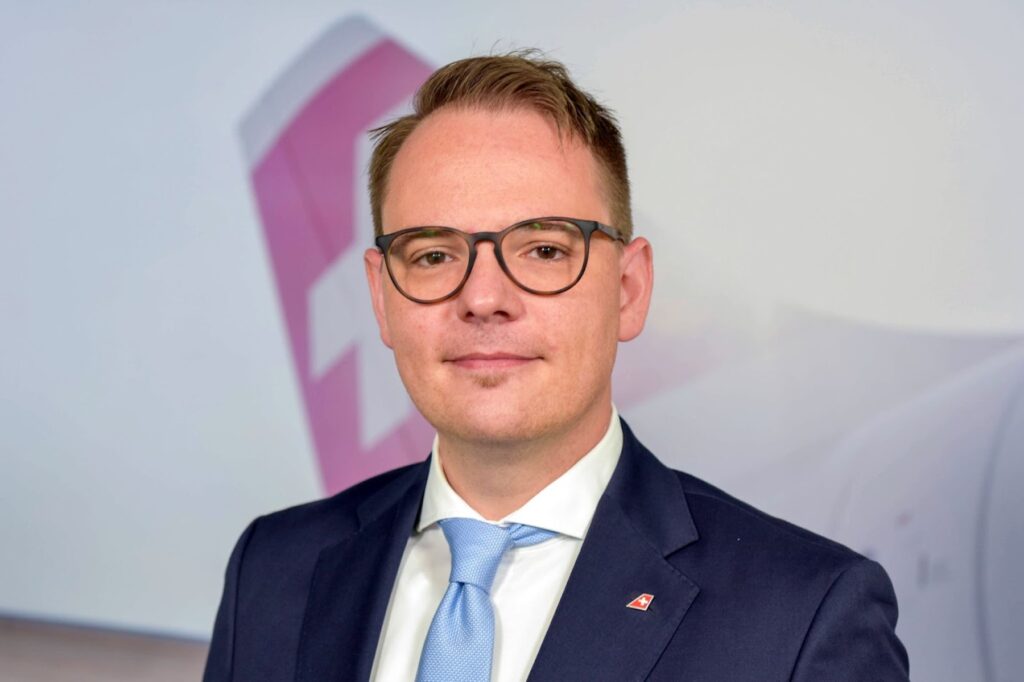Before COVID-19, many industry leaders hadn’t taken clear steps to meet the future of work head on, even when they knew what was coming. The pandemic made it abundantly clear that what leaders thought they had years to prepare for — automation, hybrid work, and changing cultures — had already arrived. The future is happening now. In a webinar entitled 5 Key Decisions to Manage the Future of Work in the Next Normal, Columbia Business School Professor Stephan Meier and Adjunct Professor Jeff Schwartz assert that executives can no longer delay decisions about the future of work and the workforce. Meier and Schwartz lay out a strategy for senior executives to re-assess how they spend their time, money, and energy to support growth and transformation in third-millennium markets.
Meier brings his expertise in growth, strategy, and leadership to the Columbia Business School Executive Education Advanced Management Program, which leverages a unique model of collaborative learning to develop leaders looking forward to new approaches. It blends interactive virtual and online modules with an exceptional experiential experience and personalized coaching sessions to create an executive education program as advanced as modern leadership requires. Managing the future of work (FoW) is increasingly a matter of reframing leadership skills in a business landscape characterized by ambiguity, rapid technological change, and changing employee expectations.
What Is the Future of Work
Just how different will the future of work look? A 2020 report by the Society for Human Resource Management and Willis Towers Watson projects that 85 percent of jobs that will exist in 2030 have not been invented yet. Whether or not that figure proves accurate, what is certain is that the decisions executive leaders make right now will impact the way workplaces evolve and how workforces adapt to unpredictable change.
Technological implementation will mark the single biggest driver of change in the future of work. It already has. During the pandemic, a rapid shift to remote work forced companies to migrate to the cloud earlier and at a greater capacity than anticipated. In 2021, 92 percent of enterprises in Flexera’s State of the Cloud Report reported utilizing a multi-cloud strategy, while 80 percent used a hybrid cloud strategy. Business executives need to think strategically about data protection and storage and cross-platform collaboration in this new era of cloud-based computing. Leaders are also facing the inevitability of automation across industries. According to PwC’s 2021 Hopes and Fears report, 60 percent of employees fear automation will put jobs at risk. Executives must manage employee expectations and assuage their fears while finding pragmatic ways to integrate artificial intelligence in the workplace.
The future of work will also include the expansion of hybrid remote work environments. Fewer employees will put in five days a week in the office. Executives are already making strategic decisions about where and how employees can work moving forward as quarantines taper off. Airbnb is the latest high-profile company to announce a new policy allowing employees to work from anywhere.
Leadership and the FoW
Schwartz and Meier use a “four + one” decision framework to help business leaders assess the state of the current work environment and use it to prepare for the future. They posit that business leaders need to consider four primary factors driving change: hybrid workplaces, leveraging work ecosystems, shifting expectations for careers, and the need for human-machine teams that make augmentation and collaboration easier. They also encourage senior leaders to focus decision-making on how initiatives can “propel business strategy forward and prepare leadership, rather than just support them.”
In the Deloitte Review, Schwartz and co-authors write that to understand the future of work, we need to consider technology, changing demographics, and “the power of the pull.” The power of the pull refers to organizations’ ability to utilize global networks and technologies to identify the right people and resources more efficiently. In both cases, these experts recommend leaders look for clues in today’s complex, technology-fueled business climate to help them respond to coming challenges.
The Redesign of Work
The digital transformation of the workplace is already well underway. Human workers collaborate with intelligent systems daily, when using Amazon’s Alexa to track appointments, smart filters and text prediction in Gmail, or digital forecasting models that leverage machine learning to make predictions and aid corporate strategy. The applications of artificial intelligence across industries are only going to continue expanding. Effective leaders don’t underestimate the power of this technology but also acknowledge that we do not yet have a full picture of the impact it will have on work and workers.
McKinsey & Company estimates that automation could raise productivity globally by 0.8 to 1.4 percent annually. “As processes are transformed by the automation of individual activities, people will perform activities that are complementary to the work that machines do (and vice versa),” McKinsey’s report reads. “These shifts will change the organization of companies, the structure and bases of competition of industries, and business models.” It is up to leaders to ensure that intelligent systems encourage, rather than hinder, productivity. That will only be possible if teams of human workers with deep domain knowledge partner with intelligent systems that can handle repetitive or complex tasks.
Executive leaders must also help their workforces weather the challenges posed by automation. McKinsey estimates that automation will replace 70 million workers in the United States by 2030. Leaders need to support robust reskilling and upskilling initiatives in their organizations, ensuring that their valuable team members have tech-enabled skillsets. The flip side of that statistic is that AI may also create 133 million new positions across industries. Leaders who take a proactive approach to AI implementation and the evolution of required skills can increase productivity while mitigating the potentially adverse effects of automation in the workplace.
The Redesign of Workforces
Workforces are changing thanks to new technologies, demographics, and global collaboration and communication methods. Leaders have more options for innovation than ever before at their disposal but may not recognize areas of opportunity if they are not primed to do so. Senior leaders who want a competitive advantage in the future of work must recognize how workforces are changing and take steps to adopt a broader global perspective.
Demographics are shifting. Older workers can work longer, and younger workers have more options for employment in a global market. Around the world, marginalized members of society are making inroads in employment equity. This is something employers should recognize and empower, according to Deloitte researchers, including Schwartz. “There’s growing evidence that more diverse workgroups and teams generate more creative and higher-impact results — an even more important reason for organizations to become more aggressive in drawing in diverse segments of the global population,” Deloitte researchers write in the Navigating the Future of Work report linked above. That is why interpersonal leadership development is an essential part of Columbia Business School Executive Education’s Advanced Management Program. Its third module prepares leaders to harness the power and perspectives of diverse teams and covers topics including leading inclusively, psychological safety, decision processes, and negotiation.
Additionally, leaders must grapple with newly distributed and widely distributed workforces. The remote work revolution driven by Covid-19 created extended or hybrid ecosystems requiring a significant mindset shift in the C-Suite. Meier warns against letting “out of sight become out of mind” when managing remote workforces. In other words, leaders should proactively take steps to ensure employees working from home do not miss out on opportunities for professional development and advancement. Leaders can prompt their own mindset shifts by asking key questions:
- How does managing people in-house differ from supporting distributed talent?
- How can leadership retain and support talent from afar?
- What does remote professional development support look like?
These questions should be baked into strategies surrounding the future of work and harnessing the potential of human capital.
The Redesign of Workplaces
The value of physical proximity as a driver of workplace culture and innovation is well documented, but it is unlikely that the nine-to-five office model will ever reemerge as the dominant workplace paradigm. “The question is not whether we should do hybrid or remote work, but how to do it,” Meier notes in the webinar. “Workers actually want to be flexible and very productive.”
COVID-19 was a learning experience for many senior executives — and a pivotal moment for workers. Organizations that had no plans to embrace remote or hybrid work were forced to do so and quickly. In many cases, the intention was that remote working arrangements would be temporary. However, a 2021 Mercer study found that 70 percent of companies surveyed planned to adopt a hybrid work model in response to employee demand. According to a Pew Research Center survey, 60 percent of workers with jobs doable from home say they would like to continue working from home all or most of the time. Many reported that it was easier to meet deadlines and be productive while working from home.
Working remotely comes with downsides that leaders must acknowledge and address. Sixty percent of workers who responded to the Pew survey said they feel less connected to their co-workers. Executives must consider how technology can create collaborative remote work environments, promote positive workplace cultures, and help distributed teams feel less distributed. It is challenging to foster workplace engagement when there is no defined workplace. Additionally, leaders must adapt their communication strategies to reduce the potential for misunderstandings over virtual channels. Perhaps most importantly, the establishment of virtual workplaces has created security vulnerabilities that did not exist previously. To keep workers and assets safe, leaders must implement heightened security measures, support workforce training in cybersecurity protocols, and appoint executive committees to oversee cybersecurity initiatives.
Preparing to Manage the Future of Work at Columbia Business School Executive Education
Managing the future of work requires not only proactive change management, but also a willingness to engage in strategic future-focused leadership development. Columbia Business School Executive Education’s Advanced Management Program is geared toward senior executives with 10+ years of management experience. Participants are dynamic and motivated to develop next-level competitive strategies for the future. Eligible applicants are either C-suite executives or within one to two steps of the C-suite. Collaborative, immersive experiences define this one-of-a-kind leadership development program.
Participants take part in an in-person immersion in New York City, where they explore the applications of strategic leadership in real-world scenarios that transcend business. According to Mattieu Chabanne, Global Head of Corporate Sales at the French international banking group Crédit Agricole, the immersion is a chance for executives to network and use each other as case studies.
“We had classes in which colleagues in the program would share issues they faced in their day-to-day, and we’d discuss ways to solve them,” he said. When one of Chabanne’s fellow participants who worked in the aviation sector discussed a problem with her company’s ticket sales, their cohort brainstormed together to find a solution. “Participating in this kind of reflection with the group allowed us to identify strategies we could apply in our roles,” Chabanne added.
On top of engaging group discussions and various exercises, the program’s curriculum blends three themes — authentic leadership, strategic thinking, and dynamic execution — in more than 50 lectures delivered by seasoned faculty and industry experts. Participants also create and present an action plan that addresses current challenges in their organizations and applies what they learn in the Advanced Management Program to implement complex change. Preparing for the future of work also requires assessing attitudes toward growth, leadership, and transformation. Participants use Columbia’s 360-degree leadership feedback tool to develop the self-awareness necessary to analyze their strengths and weaknesses in the program’s second module. Participants receive individualized career support, access to Columbia Business School’s global alumni network, and exclusive industry opportunities that serve them well in the present and are an asset in the future.
Columbia Business School Executive Education programs are future-oriented. If you’re ready to meet the changes to come head on, start your application today.



